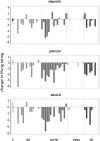Altered sense of humor in dementia
- PMID: 26444779
- PMCID: PMC4820649
- DOI: 10.3233/JAD-150413
Altered sense of humor in dementia
Abstract
Sense of humor is potentially relevant to social functioning in dementias, but has been little studied in these diseases. We designed a semi-structured informant questionnaire to assess humor behavior and preferences in patients with behavioral variant frontotemporal dementia (bvFTD; n = 15), semantic dementia (SD; n = 7), progressive nonfluent aphasia (PNFA; n = 10), and Alzheimer's disease (AD; n = 16) versus healthy age-matched individuals (n = 21). Altered (including frankly inappropriate) humor responses were significantly more frequent in bvFTD and SD (all patients) than PNFA or AD (around 40% of patients). All patient groups liked satirical and absurdist comedy significantly less than did healthy controls. This pattern was reported premorbidly for satirical comedy in bvFTD, PNFA, and AD. Liking for slapstick comedy did not differ between groups. Altered sense of humor is particularly salient in bvFTD and SD, but also frequent in AD and PNFA. Humor may be a sensitive probe of social cognitive impairment in dementia, with diagnostic, biomarker and social implications.
Keywords: Alzheimer’s disease; comedy; dementia; frontotemporal dementia; humor; progressive aphasia; semantic dementia.
Figures

References
-
- Irish M, Hodges JR, Piguet O. Right anterior temporal lobe dysfunction underlies theory of mind impairments in semantic dementia. Brain. 2014;137:1241–1253. - PubMed
-
- Snowden JS, Gibbons ZC, Blackshaw A, Doubleday E, Thompson J, Craufurd D, Foster J, Happe F, Neary D. Social cognition in frontotemporal dementia and Huntington’s disease. Neuropsychologia. 2003;41:688–701. - PubMed
-
- Kipps CM, Nestor PJ, Acosta-Cabronero J, Arnold R, Hodges JR. Understanding social dysfunction in the behavioural variant of frontotemporal dementia: The role of emotion and sarcasm processing. Brain. 2009;132:592–603. - PubMed
-
- Dopper EG, Rombouts SA, Jiskoot LC, den Heijer T, de Graaf JR, de Koning I, Hammerschlag AR, Seelaar H, Seeley WW, Veer IM, van Buchem MA, Rizzu P, van Swieten JC. Structural and functional brain connectivity in presymptomatic familial frontotemporal dementia. Neurology. 2014;83:e19–e26. - PubMed
Publication types
MeSH terms
Grants and funding
LinkOut - more resources
Full Text Sources
Medical

